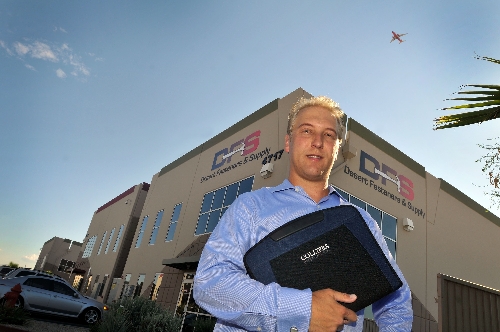Commercial real estate prices reaching one third 2007 levels
Las Vegas industrial broker Brian Riffel is seeing property come back onto the market at one-third the price it was sold three years earlier, a perfect illustration of how the commercial real estate market is taking a hit like housing.
Industrial property values have retreated to levels from the 1990s, the senior vice president for Colliers International industrial division said Monday.
He negotiated the sale of an industrial building on Post Road for $3 million in 2007 and recently sold it on a bank's behalf for $950,000.
It's part of an overall scenario in which industrial buildings sold during the real estate boom are now "underwater," or worth less than their purchase cost, with owners in danger of losing their buildings.
"I think we're pretty close to the bottom because once a bank gets a property back, you can't go any lower than that," Riffel said. "If it's good real estate, it'll sell. From a broker's standpoint, it's kind of back to fundamentals."
A combination of factors contributed to the industrial market's decline, Riffel said. Foremost is general lack of demand. Also, a lot of buildings were taken by construction-related businesses that depended on the extraordinary growth Las Vegas experienced, he said.
With the tourism industry struggling and stagnant population growth, demand for services and supplies has diminished, which in turn weighs heavily on demand for facilities.
The most common trend in the industrial market continues to be the lasting expectation among buyers and tenants for reduced sales prices and lease rates, said David Dworkin, research manager for Grubb & EIlis brokerage in Las Vegas.
Grubb & Ellis reported second-quarter average asking rent of 58 cents a square foot for industrial space. Warehouse and distribution average asking rent is 44 cents a foot, while flexible research and development space is on the higher end at 84 cents a foot.
While both residential and commercial transactions are slowly starting to pick up compared with the last couple of years, investors remain hesitant to jump back into the market, Dworkin said. Many feel that market stabilization is still a few years ahead.
"Every year, everybody has that wait-and-see attitude," he said. "Everybody wants to wait until next year. The ones that take the jump now are poised to make the most profit when things turn around."
Few industrial assets have traded since the first of the year, although there continues to be strong demand for quality properties, CB Richard Ellis reported. Rents have fallen and vacancy has increased, which only magnifies the difference between bidding and asking prices on industrial buildings for sale.
CB Richard Ellis is showing 11 percent vacancy for about 99 million square feet of industrial space in the second quarter, compared with about 8 percent a year ago.
More than 800,000 square feet of industrial space was leased during the second quarter, bringing the year-to-date lease total to 2 million square feet. That's twice the amount of leasing activity from a year ago, which is encouraging for brokers. There is no new industrial space under construction.
Brian Gordon, principal of business advisory firm Applied Analysis, said Southern Nevada's industrial sector remains weak as industrial-use employment declines further, especially any sector tied to construction. Construction employment dropped by 16,500 jobs in the last year, a 25 percent decline in work force.
With 14.1 percent unemployment and job losses that won't return in the next business cycle, there will likely be industrial overhang for years to come, Gordon said. That will keep prices suppressed.
"These corrections, while appropriate given the excess supply additions and speculation during the boom years, can be painful and have long-lasting effects on pricing," he said.
Industrial property sales reported by Colliers in April included 33,650 square feet of warehouse and distribution space at 1710 Whitney Mesa for $5.9 million, or $175.33 a square foot; Sunpac Industrial Park for $450,000, or $77.59 a foot; and Gibson Palms Corporate Park for $1.16 million, or $56.23 a foot.
Vacancy did rise to 15.4 percent in the second quarter, compared with 12.4 percent a year ago, and there's a good chance it will rise again, Riffel said.
"We're getting a lot of activity, which is going in the right direction," he said. "There are a lot of inquiries, but a lot of deals are getting done, too."
Contact reporter Hubble Smith at hsmith@reviewjournal.com or 702-383-0491.

















